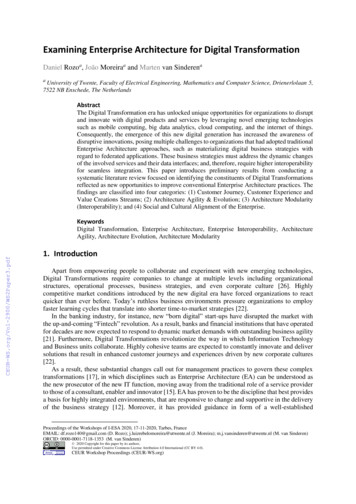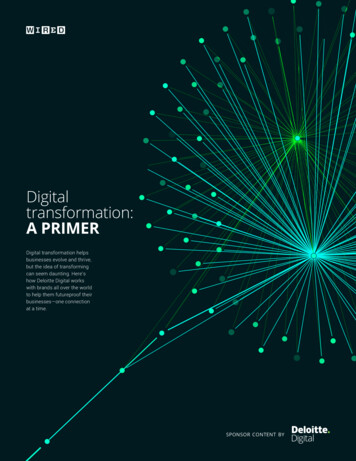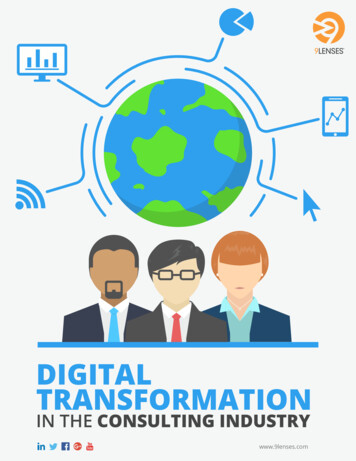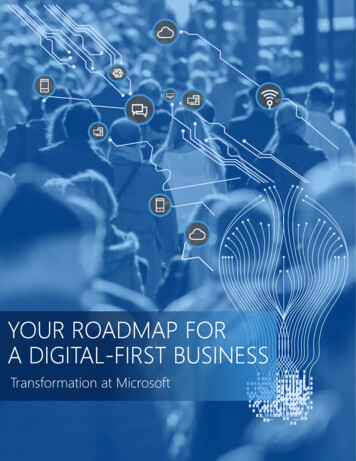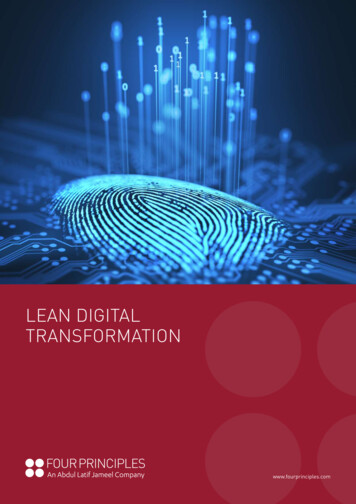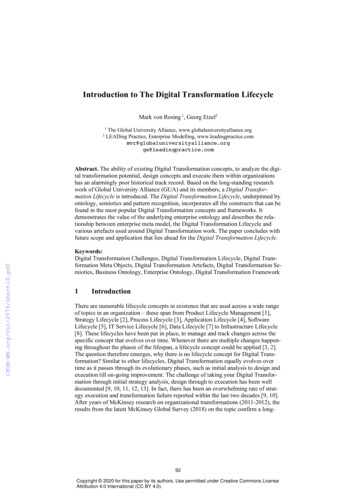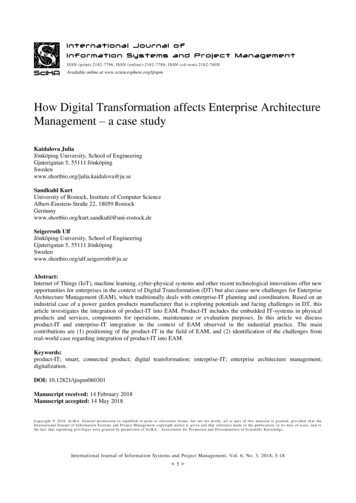
Transcription
ISSN (print):2182-7796, ISSN (online):2182 -7788, ISSN (cd-ro m):2182-780XAvailable online at www.sciencesphere.org/ijispmHow Digital Transformation affects Enterprise ArchitectureManagement – a case studyKaidalova JuliaJönköping University, School of EngineeringGjuterigatan 5, 55111 ju.seSandkuhl KurtUniversity of Rostock, Institute of Computer ScienceAlbert-Einstein-Straße 22, 18059 ostock.deSeigerroth UlfJönköping University, School of EngineeringGjuterigatan 5, 55111 u.seAbstract:Internet of Things (IoT), machine learning, cyber-physical systems and other recent technological innovations offer newopportunities for enterprises in the context of Digital Transformation (DT) but also cause new challenges for EnterpriseArchitecture Management (EAM), which traditionally deals with enterprise-IT planning and coordination. Based on anindustrial case of a power garden products manufacturer that is exploring potentials and facing challenges in DT, thisarticle investigates the integration of product-IT into EAM. Product-IT includes the embedded IT-systems in physicalproducts and services, components for operations, maintenance or evaluation purposes. In this article we discussproduct-IT and enterprise-IT integration in the context of EAM observed in the industrial practice. The maincontributions are (1) positioning of the product-IT in the field of EAM, and (2) identification of the challenges fromreal-world case regarding integration of product-IT into EAM.Keywords:product-IT; smart, connected product; digital transformation; enterprise-IT; enterprise architecture management;digitalization.DOI: 10.12821/ijispm060301Manuscript received: 14 February 2018Manuscript accepted: 14 May 2018Copyr ight 2018, SciKA. General p er missio n t o republish in pr int or elect ronic forms, but not for profit , all or part of t his mat er ial is grant ed, provided t h at t heInt ernat ional Jour nal o f I nfor mat io n S yst ems and Pro ject Manage ment copyr ight notice is given and t hat reference made t o t he publicat ion, t o it s dat e of issue, and t ot he fact t hat reprint ing pr ivileges were grant ed by per miss io n o f SciKA - Associat ion for Pro mot ion and D isseminat io n o f Scient ific Knowledge.International Journal of Information Systems and Project Management, Vol. 6, No. 3, 2018, 5-18 5
How Digital Transformation affects Enterprise Architecture management – a case study1. IntroductionToday’s dynamic business environment with its rapidly advancing information technology (IT) capabilities evolvingphenomena such as Internet of things (IoT), cyber physical systems (CPS), machine learning or self-organizing systems,presents enterprises with both new opportunities and new challenges. This opens up for new ways for enterprises toorganize themselves in terms of business models, practices, and processes, how they communicate with their customers,deliver services, perform product development etc., which is often discussed in relation to digital transformation (DT)[1] and digitalization [2] of enterprises. In general, digital transformation describes the shift from traditional (oftenphysical) creation and delivery of customer value, including the operational procedures related to this, into the massiveuse of digital technologies which enhance or replace the traditional product with smart, connected product [1]. At thesame time as enterprises see new opportunities they do face several challenges.The various aspects of an enterprise possibly affected by digital transformation include organizational structure,business processes, information systems, and infrastructure, which together form an Enterprise Architecture (EA). Themanagement of EA is a discipline that seeks to address mutual alignment between these aspects by taking theembracing perspective on the overall EA [3]. When it comes to models representing these aspects, the quality andcompleteness of information often decreases when going from top to bottom [4]. The top layers of architecture modelsusually contain more complete and up-to-date information. For lower levels information about concrete IT services andapplications is often difficult to collect and keep up-to-date. All IT solutions and application that are used at theenterprise to support its functioning and operation is what we refer to as enterprise-IT (E-IT). This part is sometimesaddressed as Enterprise Information Systems (EIS) and can include various ERP components [5]. In addition,introduction of smart, connected products increase the amount of data on lower levels, which is technologically enabledby CPS and IoT. Within CPS and IoT, data is produced by numerous communicating entities. These entities are usuallyIT-components built into the products, which we refer to as product-IT (P-IT). In particular, enterprises inmanufacturing industry, and in sectors where a lot of value creation is represented by IT-components built into theproducts, find a lot of new opportunities created by seamless and real-time integration of physical systems and IT. Useof real-time data for enterprise architecture analytics has been a challenge due to shortcomings of IT possibilities (limitsin volume, variety and speed of data collection), and by the fact that P-IT has mostly been considered separately fromEA. Advancement in the area of Big Data helped to overcome the first challenge [4], whereas overcoming the secondchallenge still requires finding a way to deal with E-IT and P-IT in an integrated manner, from managerial andoperational perspective. Even though the areas of EA, and variants of P-IT attracted a lot of research during the last 10years not much work has been done on their integration, i.e. positioning P-IT into EAM consideration. Similardeficiencies can also be found in the area of enterprise modeling techniques that are used to represent various aspects ofEA and support EA Management (EAM) [6, 7].In this context, it is observable that in industrial practice, digital transformation can have different shapes and causediverse types of challenges. There are for instance many examples of new start-ups who have managed to embrace thedigitalization wave. On the other hand, there is also evidence that more traditional enterprises with established andlegacy IT-architectures have a much harder time to embrace and to take advantage of digitalization and move theirbusiness forward into this era [6, 8]. More knowledge is needed on what methods and approaches can reliably supportDT in industrial practice.The main purpose of our work is to present experiences from integration of P-IT and E-IT as an expansion of currentEAM. Our main research question is: How can product-IT and enterprise-IT be integrated in the context of enterprisearchitecture management?In this ongoing research work, the main findings presented in this article are (1) positioning of P-IT in the field of EAM,and (2) identification of challenges from real-world cases regarding integration of P-IT into EA. The rest of the article isstructured in the following way: Section 2 presents related work and Section 3 the research method. In Section 4 anindustrial case study provides empirical evidence of the current challenges. In Section 5 we discuss the case study fromInternational Journal of Information Systems and Project Management, Vol. 6, No. 3, 2018, 5-18 6
How Digital Transformation affects Enterprise Architecture management – a case studythe perspective of our research questions and digital business models. The article ends with conclusions and ideas forfuture research in Section 6.2. Related researchThe background for our work is primarily related to EAM which is summarized in section 2.1. Furthermore, this sectiondiscusses possible implications for the EAM caused by P-IT integration in enterprise architectures in section 2.2.2.1 EAM of today (AS-IS)In general, an EAM captures and structures all relevant components for describing an enterprise, including theprocesses used for development of the EA as such [9]. Research activities in EAM are manifold. The literature analysisincluded in [10] shows that elements of EAM [11], process and principles [12], and implementation drivers andstrategies [13] are among the frequently researched subjects. Furthermore there is work on architecture analysis [14],decision making based on architectures [15] and IT governance [16]. However, there is no specific focus on theintegration of P-IT and EAM. Of specific relevance for P-IT integration are EAM frameworks identifying recurringstructures in EA. In this context, TOGAF [17] is considered by many researchers as industry standard and defines threedifferent architectural levels which are visible in many other frameworks: The Business Architecture defines thebusiness strategy, governance, organization and key business processes. The Information Architecture often is dividedinto two sub-layers: Data Architecture and Application Architecture. The Data Architecture describes the structure of anorganization's logical and physical data assets and data management resources. The Application Architecture provides ablueprint for the individual application systems to be deployed, for their interactions and their relationships to the corebusiness processes of an organization. The Technology Architecture describes the physical realization of an architecturalsolution. The logical software and hardware capabilities, which are required to support the deployment of business,data, and application services, are also defined in this dimension [17]. In addition to EAM frameworks there are alsodifferent modeling languages to support different EAM activities. One such language is ArchiMate which is widelyused for these purposes. The shortcomings of ArchiMate and its ability to address dimensions needed for digitalizationhas also been pointed out [7]. In their study they show how existing enterprise modeling approaches does not reallywork for modeling digital enterprise ecosystems. In the effort of modeling enterprise ecosystems they argue: ”Thedescribed example elaborates that we have to improvise for modeling such a simple scenario using ArchiMate” [7].2.2 EAM of tomorrow (TO-BE)Ahlemann et al. [9] define EAM as a management practice that establishes, maintains and uses a coherent set ofguidelines, architecture principles and governance styles to achieve enterprise’s vision and strategy. Facingopportunities and challenges derived from the digital revolution, business leaders need new ways to conduct effectivestrategic decisions related to the increased digital enterprise [18]. With the huge diversity of IoT technologies andproducts enterprises have to leverage and extend previous EA efforts to enable business value by integrating the conceptof digital into their business environment [19].The impact of digitalization on enterprise systems in modern manufacturing is discussed in [20], which claims that IoTcan support information systems of next-generation manufacturing enterprises effectively. Data acquisition systems aresuitable to be applied in collecting and sharing data among manufacturing resources. However, they argue that theapplication of IoT in enterprise systems are at its infant stage, more research is required in modularized and semanticintegration, standardization, and the development of enabling technologies for safe, reliable, and effectivecommunication and decision-making. On the way towards IoT-inclusive EAM, [19] and [21] consider integrating thegrowing IoT architectural descriptions into a consistent enterprise architecture as a significant challenge.International Journal of Information Systems and Project Management, Vol. 6, No. 3, 2018, 5-18 7
How Digital Transformation affects Enterprise Architecture management – a case studyIn [21] an approach for the IoT application development is proposed, which includes a role-specific developmentmethodology, and a development framework for the IoT. Architecture evolution approach proposed in [22] relies on theidea of integrating small EA descriptions (for each relevant IoT object) into a coherent EA description. EA-IoT-MiniDescriptions include partial EA-IoT-Data, partial EA-IoT-Models, and partial EA-IoT-Metamodels that are associatedwith main IoT objects defined by the approach. Another initiative that tries to overcome these challenges is thelightweight EAM framework for digital transformation by [23]. This framework has its origin in TOGAF 9.1 with afocused customization.One challenge that is apparent today in the digital transformation is the to handle the bimodal dimensions of the ITlifecycle [24]. The E-IT dimension (Mode1), designed for stability, efficiency, and low cost, which is closely related totraditional EAM. P-IT on the other hand (Mode 2) is constituted by development projects that help to innovate ordifferentiate the business. This requires a high degree of business involvement, fast turnaround, and frequent update, theso-called rapid path to transform business ideas into applications. In the literature this is acknowledged through thatthere is a need to handle “A two speed architecture for the digital enterprise” [8]. For digitally native enterprises andstartups such as for example Netflix this is not a problem [8], since they have had the benefit of starting with a “cleanslate” and think “digital” and take the advantage of this from the beginning without considering any legacy. This doeshowever not work for more established enterprises. They have many years of delivered technology, architectures,governance, decisions structures, etc. The objective of the two-speed architecture is to differentiate the systems,architectures, and structures that must be flexible and agile (P-IT) from those that have to be more reliable and deliverthe highest quality (E-IT) [8]. This approach will have to cut through the different layers of the technology stack and isas much about organizational architecture and process architecture as it is about technology architecture. Someresearchers have proposed an architecture aiming at information system agility and scalability, for example [25]. Inaddition to this [1] have suggested to handle modern digital informed infrastructure through a new technology stack. Inthis structure they suggest an integration of P-IT and E-IT through three interrelated layers that include Product Cloud,Connectivity, and Product. We find this approach promising but we argue for that there still is a need for furtherelaboration of integration of P-IT and E-IT. Even if we have a two-speed architecture these two requires elaborated andsystematized interconnectivity and they should have the ability to deliver a collaborative support for different businessand customer activities.The increased adoption of digitalization through IoT, data analytics (big data), and cloud computing has opened newways of thinking in many dimensions; customer involvement, optimized processes, and business models. In terms ofbusiness models [26] has presented a new business model that can be more suitable for organizing business in an IoTage. This and other new business models emerging in the digitalization age will have impact on the EAM practice.Furthermore, our observation is that there is neither a common understanding of the scope and content of the mainactivities in EA management and IoT or P-IT integration, nor has a commonly accepted reference method beendeveloped [27]. EAM currently concentrates on E-IT side including number of its layers, whereas P-IT, i.e. what is builtinto the products or supporting industrial automation, is mostly outside of EAM consideration.3. Research methodFrom a method perspective, the work followed the case study research approach. In addition to the case study wereviewed existing publications using digital product and enterprise architecture as a search terms. There are severalrelevant studies available published between 2014 and 2017, which are described above in the Related Researchsection. During the analysis of existing literature, we observed that there is not much work on the integration of P-ITinto EA, however we could clearly see that the interest in this integration is growing. Thus, our investigation of anindustrial case in this subject area aimed to better understand the challenges, hinders and potential integration paths.Qualitative case study is an approach to research that facilitates exploration of a phenomenon within its context using avariety of data sources. This ensures that the subject under consideration is not explored from only one perspective, butrather from a variety of perspectives which allows for multiple facets of the phenomenon to be revealed and understood.Yin differentiates various kinds of case studies [28]: explanatory, exploratory and descriptive. The case study can beInternational Journal of Information Systems and Project Management, Vol. 6, No. 3, 2018, 5-18 8
How Digital Transformation affects Enterprise Architecture management – a case studyclassified as exploratory. We explore the phenomenon of P-IT in its natural organizational context. As focus of the casestudy, we decided to address the P-IT/EA integration from an architectural and a management perspective. Thearchitectural perspective addresses commonalities in structure and components of P-IT and enterprise architecture. Themanagement perspective concerns procedures for architecture development, implementation and maintenance. The aimof the case study was to see how the existing EAM practice was affected and challenged by implementing new type ofproducts – physical products with built-in software. More concrete, the case study explores the following researchquestions:Does the architecture of product-IT in the case study show similar levels as known from traditional EA?If it is possible to either discover such levels or to assign existing components to these levels, an integration could bediscussed using established EA layer thinking. If not, more substantial changes to enterprise architectures would berequired to facilitate an integration.Are there existing or potential commonalities between product-IT architectures and EA?Existing commonalities could be existing services developed for both parts or processes running “across” botharchitectures. Potential commonalities are functionally similar or equivalent services or structures.What are the central roles in product-IT management and are these roles comparable to the roles in EAM?P-IT management is in this context supposed to include product management, architecture definition and integrationinto the overall architecture.What are the cooperation processes between EA and product-IT architecture management?If cooperation is established and common practice, how do the processes look like, and do they cover all architecturelevels?In the case study, we analyzed documents of the case study company, performed interviews, and modeling activities todescribe the current AS-IS situation. The analyzed documents provided information regarding the existing architecturaland managerial practices related to digital products and services at Husqvarna. Eight interviews were performed as partof the case study, all having semi-structured character. Semi-structured interviews enabled in-depth investigation thefocus area and allowed capturing the respondents’ perspective on a situation and event under study [29]. Semistructured interviews imply using a predefined list of questions but allows the interviewer to follow up on leadsprovided by participants for each question (ibid). The interviews were carried out at Husqvarna Group AB, one of therespondents takes a top management position in of architecture and digital solutions at Husqvarna, whereas the otherrespondents were project managers, product owner, enterprise architects, and squad leaders. The chosen respondentswere key stakeholders within a project of developing a new digital product at Husqvarna, part of them wererepresenting P-IT side, whereas another part - E-IT side. The interviewer followed prepared interview guide connectedto the four research questions outlined above. The questions in the interview guide aimed to explore the challenges thatthe respondents have faced and observed in relation to EAM practice and digitalization demands/opportunities, as forinstance, increasing number of P-IT entities that companies need to deal with, the considerable influence these P-ITentities have on the amount of data produced, ability to manage and analyze the produced data, and the ability tomanage it in an integrated way with an E-IT.During the modeling activities we together with the different roles at Husqvarna have created descriptions (interactionmodels) of how these roles (project managers, product owner, enterprise architects, technical architects, and squadleaders) interact with each other, what the interactions objects are, and the interaction logic. This way of working withmodels have elucidated several challenges in their work with taking a substantial step into the digitalization age. Anexample of such an interaction model can be seen in the Figure 1.International Journal of Information Systems and Project Management, Vol. 6, No. 3, 2018, 5-18 9
How Digital Transformation affects Enterprise Architecture management – a case studyTechnicalproductownerTest (wholeproduct anningBackloggroomingBudgetlimitsRequirements,Use casesTest teamSupport(agilecoaching)Planing,Finance,Customer req.ProductownerSquadEAM teamPatterns& antipatternsProductlibraries &frameworksImplementation alignmentissuesR&DSystemreq.System &solutionarchitectureDataBig rmCore teamFigure 1: Overall interaction model4. Industrial case studyThe industrial enterprises considered in the case study is Husqvarna Group AB. Husqvarna is a world-leading producerof outdoor power products including chainsaws, trimmers, robotic lawn mowers, garden tractors, watering systems,cutting equipment, and diamond tools for the construction and stone industries. Husqvarna is multinational and offersproducts and services for both the private and industrial market. Husqvarna is right now in a transformation processwhere they see it as a necessity to embrace the digitalization trends that is been presented above to stay competitive andto deliver improved value to their stakeholders.Many of the Husqvarna products for professional customers do not only have built-in electronics or embedded systemsbut also networking and communication capabilities. The built-in IT is in many cases used for controlling the differentmechatronic components of the product and for collecting data when the product is in use, either performanceparameters or used product features, or the environment of the product. The networking features are used forcommunicating usage statistics, license information or location information (if anti-theft features are activated) to eitherthe product owner or the back-office of the manufacturer. Other functions are software upgrades and functionality addons implemented by configuration changes (e.g. for optimizing energy consumption).Figure 2 illustrates a typical scenario from a customer perspective. Different Husqvarna products are installed forsupporting maintenance of the garden, all of them equipped with wireless communication. Among them is a fleet ofrobotic mowers (1) and a lawn watering system (5). The robotic mowers and the watering system communicate witheach other to synchronize mowing and watering, but they also provide operations data to the base station (2) and receivesoftware updates or schedules from it. The base station is connected to the cloud by using the customer’s Internetaccess. In the cloud, Husqvarna backend and customer services are available (3). Thus, the owner of the garden hasaccess to services for operating, supervising and planning garden maintenance using mobile devices (4).Since many of the products offer similar functionality regarding networking and communication, Husqvarna designedand implemented reusable services and components for either the product or the back-office infrastructure whichcomprise an IT and service architecture for the P-IT. To support all P-IT development teams Husqvarna introduced ateam that is responsible for tools and standards for software development. This team is providing so called commondevelopment platform for all P-IT development teams.International Journal of Information Systems and Project Management, Vol. 6, No. 3, 2018, 5-18 10
How Digital Transformation affects Enterprise Architecture management – a case studyFigure 2: Scenario illustration“Me and my team we are responsible for the common parts that all the teams are using for the development. Forexample, task management tools like JIRA and Confluence, build server, address verification system, source codemanagement. We are also managing cloud infrastructure. All the teams are responsible for their own environments, butif they for some reason fail or need support they come to me and my team for help. We also try to outline commonpatterns, so they don’t have to reinvent the wheel all over again, a lot of the things they want to do are common amongall the teams.” (Respondent 2)One example of a common development platform component is a task management system JIRA. The decision to makethis ticket management system “standard” originated from different product teams and their shared choice. This helpedto avoid using several instances of JIRA and prevent situations when one person had to work in multiple instances ofJIRA or use different task management systems for different projects.“E-IT is obviously responsible for the IT environment and infrastructure, but it happens now and then that we also havesome “shadow IT”. Development teams are using IT off the radar, sort to say.” (Respondent 3)Similarly, the common development platform dealt with the issue of multiple servers for source code management.Establishing the common development platform allowed to optimize software development and maintenance in terms ofsupportive tools and methods, and to avoid having isolated development infrastructures with overlapping functionalityfor different P-IT development teams.Another important issue is license management services - to take one example - for product licenses (in P-IT) andsoftware licenses (in E-IT) is. Can both service types be based on the same technical infrastructure and use the sameencryption and logging services (to take just two examples)? If so, why not define common EA elements on applicationarchitecture level for P-IT and E-IT?A core challenge for Husqvarna to handle the integration of P-IT and E-IT is to handle the bimodal dimensions of the ITlifecycle which is closely related to the concept of bimodal architecture.“Product owners are sometimes caught in their traditional way of working. They have their product model, you have topass those all the toll gates in that model. That is an obstacle I think.” (Respondent 1)“Historically we have a product-centric organization where we have a planning period of one year at a time, with aspecified budget each year. At the end of the year we are expected to have a product out on the market. With the newtypes of products, the development team is developing a service or system that is always available, which is differentfrom when you develop a product: you put it on the shelf with more or less no cost. You could fire the entiredevelopment team after that if you like, as you still have it on the shelf. Doing that for a service or system that you haveInternational Journal of Information Systems and Project Management, Vol. 6, No. 3, 2018, 5-18 11
How Digital Transformation affects Enterprise Architecture management – a case studyto operate with the whole backend is not working. Especially when we are talking about mobile apps, for which peopleare expecting updates. Therefore, even for a minimum level of maintenance for a system we need to calculate for that.The way that this has been done before is that the maintenance would be included in the next year project, whichtherefore most of the times will not be budgeted correctly.” (Respondent 2)The E-IT dimension (Mode1), designed for stability, efficiency, and low cost, which is closely related to traditionalEAM. P-IT on the other hand (Mode 2) is constituted by development projects that help to innovate or differentiate thebusiness. This requires a high degree of business involvement, fast turnaround, and frequent update, the so-called rapidpath to transform business ideas into applications. To handle this Husqvarna is implementing DevOps Teams designedfor agility, rapid development and short time to market. In Husqvarna these two modes (Mode 1 & Mode 2) are closelyrelated to the concept of two speed architecture as presented earlier.“It is quite a pain when we have this funding process that goes in collision to our agile way of thinking. So, if we aretalking about this bi-modal development process – we (P-IT development team) are working in mode 2. But almostevery process is defined for mode 1 so we have to come up with creative solutions every time. We try to find a way tofund our way of working agile and follow the guidelines for the Husqvarna process, the funding process.” (Respondent4)Today Husqvarna experience a clear tension between Mode 1 and Mode 2 and they give testimony of several morespecific challenges in relation to the bimodal dimensions of IT, such as governance and responsibilities betweenresearch and development and IT, how to increase speed and suitable methods to support agile teams. Also, how tobalance governance and support between P-IT and E-IT, lack of frameworks to describe
guidelines, architecture principles and governance styles to achieve enterprise's vision and strategy. Facing opportunities and challenges derived from the digital revolution, business leaders need new ways to conduct effective strategic decisions related to the increased digital enterprise [18].



